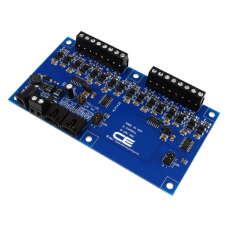8-Channel 0-10V Analog to Digital Converter with I2C Interface
This Analog to Digital Converter Board is capable of reading 0-10V input voltage. It has on-board Amplifier for signal conditioning. This Board uses two MCP3428 to read the amplified Signal. The MCP3428 is a 4-Channel Analog to Digital Converter with 16-Bit resolution, ideally suited for low-speed high-resolution sensor monitoring. The MCP3428 is capable of reading analog voltages at 15 samples per second with 16-Bit resolution or 240 samples per second at 12-bit resolution. The MCP3428 has an x1, x2, x4, x8 programmable gain amplifier, making it an ideal choice for monitoring extremely low-voltage sensors. All 8 channels are capable of monitoring a full-scale range of 0-10V. Up to 8 MCP3428 devices are capable of sharing a single I²C communication port, using floating address inputs.
This 0 to 10V Analog to digital Converter board has 2 MCP3428 onboard, so to use both at the same time you will need to setup both at a different address. This Analog to Digital Converter board has on-board jumpers to select the different-different addresses for both of the MCP3428.
Note: Set MCP3428 gain at one to read 0-10V Signal and set the gain at two to read 0-5V Signal.
What is the NCD I2C Interface?
NCD is the creator of plug and play modular hardware using the NCD I2C Interface connector standard. NCD I2C devices allow you to chain together several devices on the I2C bus, and communicate to each device individually at high speed (subject to the limitations of I2C). The NCD I2C Interface uses a standard 4-Pin I2C Input and I2C Output connector. NCD I2C devices communicate 5V I2C data and provides 5V DC power through this connector. NCD I2C devices use standard I2C communications for all data transport, which is supported by nearly every microcontroller in production today. The NCD I2C Interface is strictly a 5V standard, which is ideal for transport across longer cables. NCD I2C devices always include a 6″ (152mm) 4-conductor I2C cable. NCD I2C Mini Modules always include a 3″ (76mm) 4-conductor I2C cable. Cables and connectors are available separately for designers who would like to include their own NCD I2C Interface into their designs.
Plug and Play Connectivity
NCD I2C devices will plug in to any available NCD I2C Output. This includes just about everything we make in the NCD IoT Category, including all NCD IoT devices. We also manufacture a wide range of I2C adapters that make it easy to plug NCD I2C Devices directly into most computing platforms. The NCD I2C Interface adapters are available for Arduino, Banana Pi, BeagleBone, Bluz, C.H.I.P., ESP8266, Onion Omega, Particle Photon and Electron, PyCom, Raspberry Pi, 2, 3, and Zero, and Windows. We are always working to add new platform support for NCD I2C devices. NCD I2C Interface devices are compatible with just about everything in the microcontroller industry.
Unlimited I2C Expansion
Based on our plug-and-play I2C interface standard, all NCD I2C devices are equipped with a I2C output port, making it easy to expand to a wide variety of sensors, current monitors, relay controllers, PWM controllers, and much more! We are always designing new expansions for our modular plug-and-play I2C framework. We are dedicated to building a product line of interconnected devices to simplify all forms of automation. Re-use or upgrade your hardware in seconds by selecting the modules that best fit your needs, and chaining them together using the included I2C expansion cables!
Powering NCD I2C Interface Devices
Some NCD I2C devices require a external power supply, others may be powered through the 4-Pin I2C bus connector at 5VDC, and other devices are jumper selectable between external and I2C bus power. All I2C mini modules are powered through the 5V I2C bus connector, greatly simplifying connectivity.
Features
- 8 Channel ADC with 16-Bit Resolution
- 0-10V DC input Voltage Range
- Programmable x1-x8 Gain Amplifier
- Up to 4 Devices per I²C Port
- Up to 3.4MHz Communication Speed
- 0x68 Start Address
- On-board Power Management
Enter the code in the box below:


